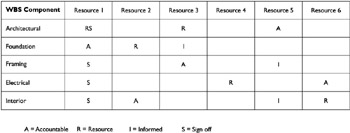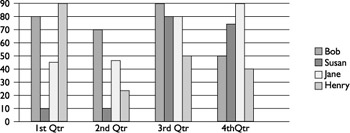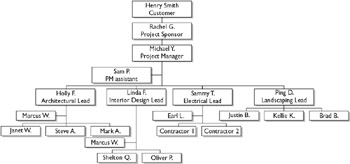Examining Organizational Planning Results
|
| < Day Day Up > |
|
Organizational planning is part of the overall planning processes so it, too, is iterative. The outputs of organizational planning should be reviewed periodically throughout the project to ensure completeness and accuracy. Should events, people, or stakeholders change throughout the project, the following outputs of organizational planning should be updated to reflect the changes.
Creating the Role and Responsibility Assignments
There are slick definitions for roles and responsibility:
-
Role Who does what
-
Responsibility Who decides what
The assignment of the roles and responsibilities determines what actions the project manager, project team member, or individual contributor will have in the project. Roles and responsibilities generally support the project scope since this is the required work for the project.
An excellent tool that the project manager should create is the Responsibility Assignment Matrix (RAM). A RAM can be high-level-for example, mapping project groups to the high-level components of a WBS, such as architecture, network, or software creation. A RAM can also be detailed specific to the activities within the project work. Figure 9-4 is an example of a RAM.

Figure 9-4: A Responsibility Assignment Matrix can map work to project team members.
Creating a Staffing Management Plan
The staffing management plan details how project team members will be brought onto the project and excused from the project. This subsidiary plan documents the process the project manager is expected to complete to bring new project team members aboard based on the conditions of the project.
For example, a project may require an application developer in the third phase of the project. The project manager may have to complete a job description of what the application developer will be responsible for, how their time will be used, and how long the role is needed on the project. HR or other functional managers may have to approve the request.
Management may also want to see a resource histogram, as Figure 9-5 illustrates, so they may plan employees' time and activities accordingly. Management may elect to hold off on the launch of a project based on the requirement for resources and the conflict with business cycles or other projects with higher priorities within the organization.

Figure 9-5: Resource histograms illustrate the demand for labor.
Each performing organization will likely have policies and procedures that should be documented, and followed, to bring resources onto the project team. In addition, the organization may have similar ways to excuse project team members from a project once their contribution has been completed.
The staffing management plan should
-
Detail how project team members are brought onto and released from the project
-
Account for employees' time on the project
-
Use employees as needed, and when needed
-
Remove or reduce worries about employment by communicating the expected need for resources
Exam Watch
Scheduling unneeded resources is a waste of time and money. Only schedule resources on a project when they are needed. Functional Managers may want you, the project manager, to schedule resources on a project even though you don't need them. Not only is this outside of the staffing management plan it is a violation of the project management Professional Code of Professional Conduct.
Creating an Organizational Chart
An organizational chart can help the project manager and the project team identify the reporting relationships among the project team, management, and other key stakeholders. Figure 9-6 is an example of an organizational chart, or org chart. The org chart can help the project manager identify what communication protocols are used in a large project. Org charts can also identify the relationship of team members and contributors in a smaller project.

Figure 9-6: Organizational charts identify reporting relationships within a project.
An organizational breakdown structure (OBS) is also an organizational chart. This tool, however, identifies the organizational units or departments and what work packages they are responsible for within the project.
Documenting the Supporting Detail
The details influencing project decision should be documented. This supporting detail allows the project manager and management to reflect on why decisions were made. Supporting details may include:
-
Organizational impact The project manager should identify the reasoning behind the decisions that were made. Specifically, if alternatives were identified, the project manager should explain why the alternatives were not selected in lieu of the plans that were created. This information can prove valuable later in the project if management needs to know the rationale behind the project manager's decisions.
-
Job descriptions These position descriptions define the job requirements, responsibilities, authority, and other details about the positions within the project team.
-
Training needs If the project team needs training in any area to complete the required work of the project scope, the project manager should identify and document the needs of the project team. Information on the type of training needed, the cost, modality, and reasoning why the training choice was selected should be included in this documentation.
|
| < Day Day Up > |
|
EAN: 2147483647
Pages: 209